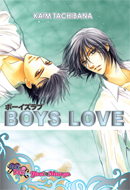   |
Manga-ka: Kaim Tachibana
Publisher: Doki Doki
Rating: Older Teen (16+)
Release Date: November 2009
Synopsis: “Magazine editor Mamiya meets popular high school model Noeru Kisaragi for a story Mamiya’s working on. When Noeru suddenly tries to go down on Mamiya and makes sexual advances at him, Mamiya turns him down flat. But Mamiya’s loneliness starts to get to him and he decides to try starting over with Noeru on equal footing. Mamiya’s sincerity causes Noeru to open his heart as well, and before long the two begin to form a deep emotional connection, but…”
One problem I have with many yaoi manga is the sense they give that if a relationship isn’t some earth-shattering love-story to end all love stories, then it’s just not worth it. Not every couple has to be soul mates destined to be together forever and ever. This may make me sound like a cynical, unromantic grouch, but some love stories could really be helped by dialling back the melodrama. Boys Love is a good example of this.
The manga starts off on the right foot with Mamiya, a young magazine editor who has been assigned to write an article about a young male model named Noeru. While Mamiya is slightly older than Noeru, he’s a lot more naive and a lot less jaded than the young model. So when Noeru makes a pass at him, Mamiya is surprised and rejects the high school student. This leads to Noeru playing mind games with Mamiya, getting him into trouble at work. Eventually, Mamiya goes to Noeru’s apartment to confront him. There Mamiya finds out that Noeru is living a self-destructive life-style: he drinks, he sleeps with a different guy every night, and only gets by in school because his friend Chidori helps him cheat.
Seeing how Noeru is wasting his life, Mamiya steps in. A really nice part of the book is seeing the stages the main characters’ relationship goes through. Like in many rom-coms, they start out hating each other, but unlike other series where the leads immediately fall into bed, Mamiya and Noeru take their time. In fact, their friendship is more powerful than their love story. There’s one page where with just a few wordless panels the manga-ka is able to convey the fact these two guys are spending a lot of time together and are growing closer. There’s some really nice character development for both Mamiya and Noeru as we see the effect they have on each other.
There’s an important third character who also grows over the course of the book: Noeru’s friend, Chidori. Chidori is Noeru’s childhood friend who knows the secret of his past and is obsessed with staying at his side. Over the course of the book Chidori’s devotion to Noeru gets pushed to the limit, making him take extreme actions.
I could buy Chidori’s actions at the end of the book. The manga-ka does a good job of showing the reader where he’s coming from and how his mind works. What I can’t buy is how the main characters react to it. This is where the book goes from telling a story about Mamiya and Noeru’s budding romance to being about how they were meant to be together forever and always. Their relationship quickly goes from being relatively realistic to being overblown, all in the space of a few pages. It’s not the end that bothers me so much as the strange tonal shift that comes with it.
The art is beautiful. The boys are prefect examples of shojo pretty boys. I like that Mamiya does look a little older than Noeru but still manages to appear more innocent. The layouts all work really well. There’s one sequence set partially underwater that is especially well done, but the whole book is laid out nicely. The layouts help with the pacing of the story, something important in any medium but especially in a one-volume manga.
Pacing is another thing I really liked about Boys Love. Many one-volume yaoi manga end up being rather choppy and episodic. This is understandable: often times the manga was only supposed to last a chapter or two and then the manga-ka was asked to expand it, or the book might end on an open-ended note in case it gets a second volume. But with Boys Love you get a compact, one volume story. Some yaoi volumes are often little more than a collection of short stories featuring the same leads, but Boys Love actually has a beginning, middle, and end. In that sense it really earns the title of graphic novel.
A lot of people probably won’t mind the end, as it’s no worse than many other melodramatic love stories. It just feels like a betrayal to the story that had come before it. Despite that, I’d still recommend Boys Love to anyone who likes, well, boys’ love.
Review written November 26, 2009 by Shannon Fay
Book provided by Digital Manga for review purposes


 Follow
Follow
























[…] 1 of Biomega (Anime Sentinel) James Fleenor on vol. 1 of Black Bird (Anime Sentinel) Shannon Fay on Boys Love (Kuriousity) Lori and Krissy Henderson on vols. 1 and 2 of Choco Mimi (Good Comics for Kids) Lissa […]
As a reader who is entirely OK with both melodramatic melodrama and with Grand Sweeping Romances, I hated the end of this book. With the exception of a bare handful of feel-bad, emotional-slasher-movie yaoi that have never been translated, the entire point of the drama-o-rama yaoi is that after all the melodrama and the angst and the tears, the guys work out their problems and live happily ever after in a cloud of rainbows and bluebirds. Boys Love totally failed to deliver. I can't believe Tachibana's editor let her end the story that way.
I read this book as well before Shannon's review was posted and I really disliked the ending too. It was so… in many ways non-existent and in other ways sort of insulting to readers. I've seen that kind of open-to-interpretation ending work before but this was certainly not an example of that.
I read the book and was disappointed with the ending. The dramatic melodrama didn't fit with how the story was unfolding. I rented the movie through Netflix and didn't realize it was the same story as the manga until too late. I couldn't watch the ending. It was too painful.
So is the movie an adaptation of the manga or is the manga an adaptation of the movie? I never figured that out.